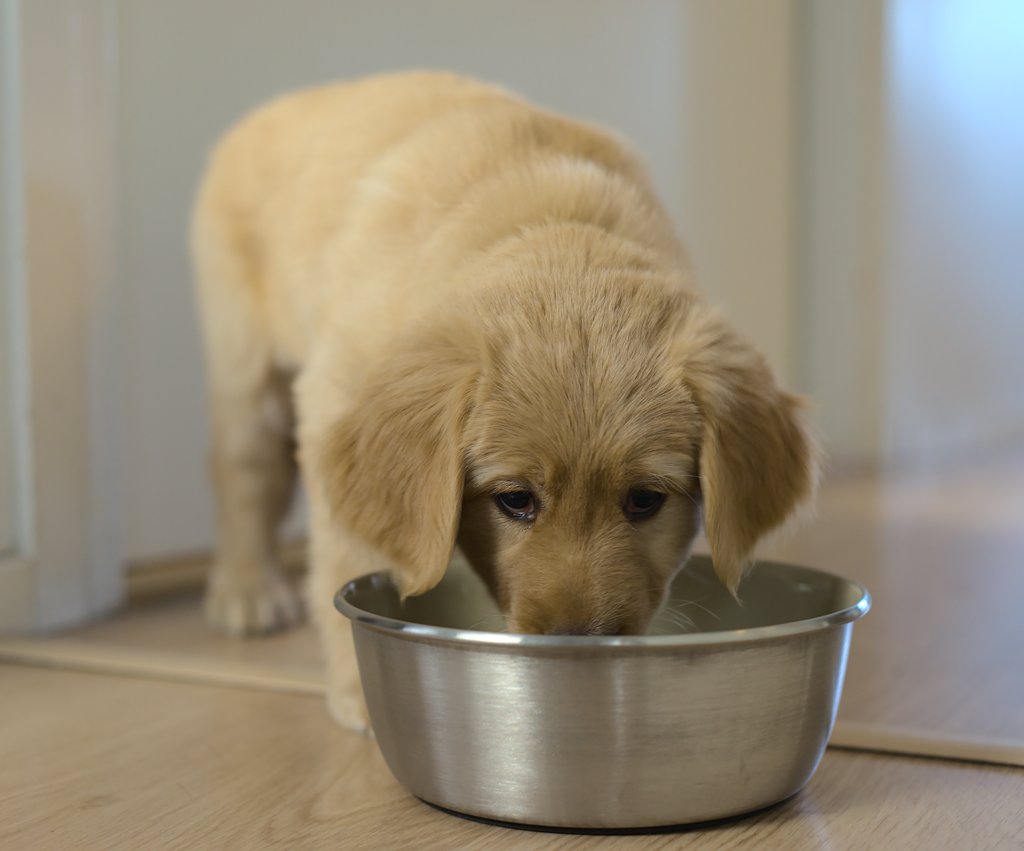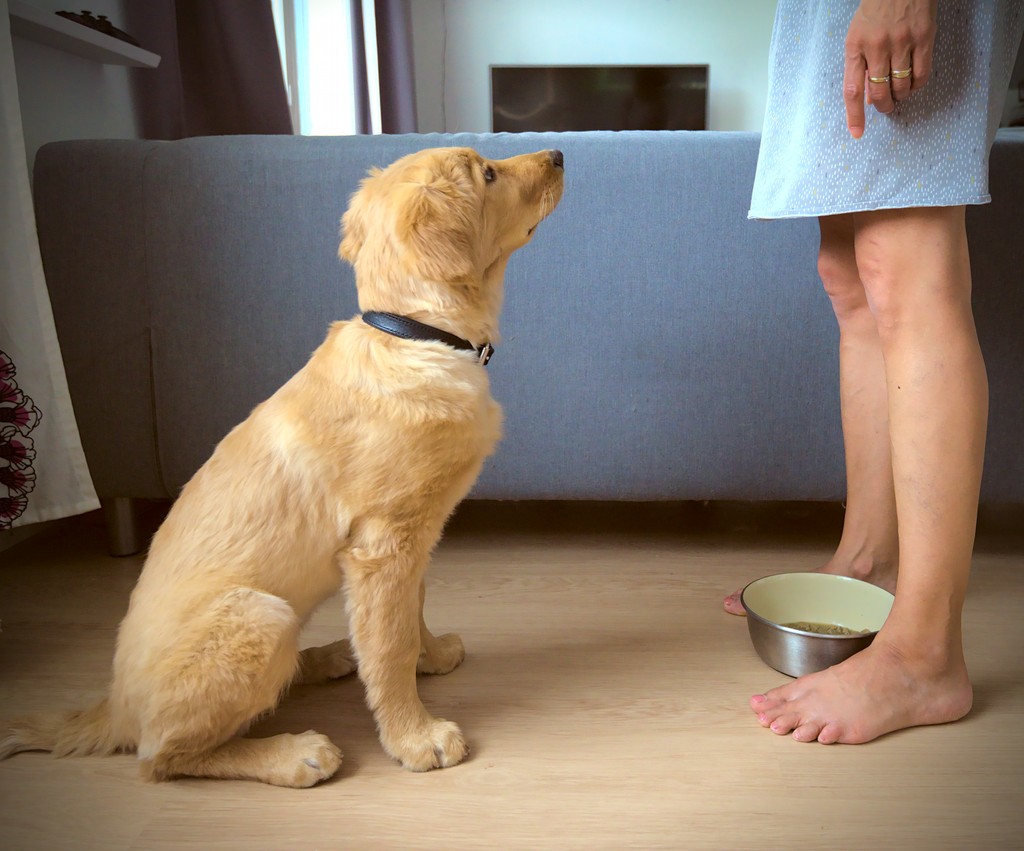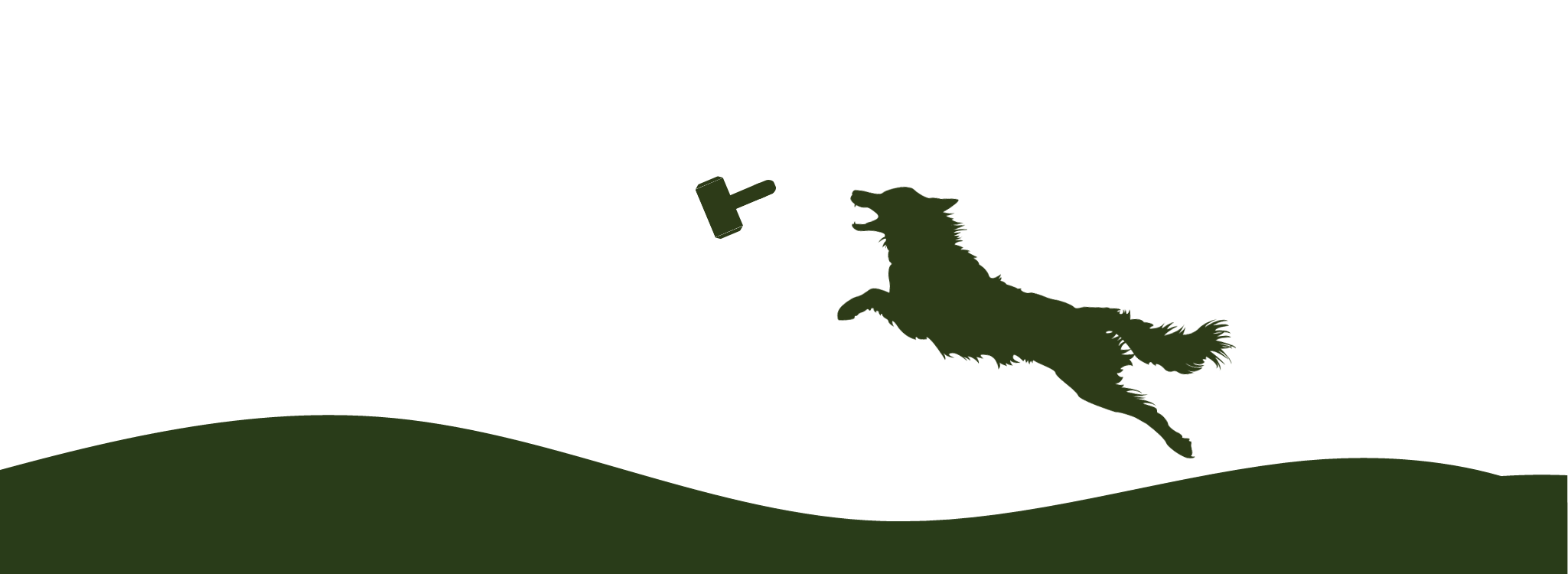Measure Twice: How much does a dog eat?
Table of Contents

The crux of the problem lies in the fact that food manufacturers announce daily portions as weight in grams and you measure the quantity with the help of a measuring cup, which tells you the volume. Below, you will learn how to convert the daily portion in grams into a number of measuring cups per day.
The quantities I present in the example charts below should be treated as upper limits, meaning that you most likely shouldn’t be feeding your dog as much as suggested by the food manufacturer. The only way to make sure is to weigh your dog regularly, a topic which I will cover in the next section.

As stated above, the only way to make sure that you’re feeding your dog properly is to weigh her regularly and reduce the portion size if she is gaining weight too fast and increase it if she is not gaining weight fast enough. Often, the problem, however, is over-feeding, meaning that for example a large breed puppy should not gain more than a kilogram of weight per week.
For smaller dog breeds, you will have to take into account her ideal weight as an adult, so for example if your dog will weigh 10kg as an adult, the rate should probably be less than 1kg per month. Below, I present two feeding chart examples supplied by a dog food manufacturer called Eukanuba. The first table is for large breed puppies and the second one for large breed adults.
Example 1: Eukanuba Puppy Large Breed Feeding Chart #
The chart below, presents the daily portions for a puppy based on her weight and age. In my experience, they should be treated as upper limits and the only way to make sure is the weekly weigh-in. For example, for a two month old puppy weighing 6kg, the daily upper limit should be 305 grams of Eukanuba growing puppy kibble per day.
| Puppy’s weight | 1 - 3 months | 3 - 4 months | 5 - 7 months | 8 - 12 months | 12 - 14 months |
|---|---|---|---|---|---|
| 2kg | 145g | - | - | - | - |
| 4kg | 235g | 205g | - | - | - |
| 6kg | 305g | 270g | - | - | - |
| 8kg | 375g | 330g | 220g | - | - |
| 10kg | 435g | 380g | 255g | - | - |
| 15kg | 570g | 500g | 335g | 265g | - |
| 20kg | 690g | 610g | 405g | 325g | 295g |
| 30kg | - | 795g | 530g | 425g | 385g |
| 40kg | - | 965g | 645g | 515g | 465g |
| 50kg | - | - | 750g | 600g | 545g |
| 60kg | - | - | 845g | 675g | 615g |
| 70kg | - | - | - | 750g | 680g |
Example 2: Eukanuba Adult Large Breed Feeding Chart #
Feeding adult dogs is much simpler as the only thing you have to consider is their body weight, which of course depends on the breed and sex of your dog. For Hovawarts for example, an adult female weighs somewhere between 30 and 35 kilograms, which will mean that her daily portion is somewhere around 330 grams of Eukanuba adult kibble per day.
| Dog’s Weight | Grams of Kibble Per Day |
|---|---|
| 20kg | 205 - 230 g |
| 30kg | 270 - 300 g |
| 40kg | 330 - 365 g |
| 50kg | 980 - 425 g |
| 70kg | 475 - 530 g |
| 90 kg | 565 - 625 g |
How to measure food quantity in grams then? #
As stated above, it is in the interests of food manufacturers to maximise the consumption of their product. They announce the recommended daily portions as grams dependent on your dog’s age and weight.
The easiest way for you to determine the maximum daily portion for your dog is to weigh her food with the help of a kitchen scale. Luckily, you will only have to do this once, whereafter you should be able to adjust the portions based on this measurement.
How-to: Determining Daily Kibble Portion Size #
To determine how much food you should feed your dog per day, please do the following:
- Place an empty measuring cup on a kitchen scale and note down the result in grams.
- Fill the cup with your dog’s kibble and note down the combined weight.
- Subtract the weight of the empty cup from the combined weight and note down the result.
- Look for the manufacturer announced maximum daily portion in grams printed on a bag of kibble. The daily portion is usually determined by your dog’s weight. If you don’t know your dog’s weight, then the next section will teach you how to weigh her.
- Divide the daily portion from step 4. with the result of step 3. This will tell you how many measuring cups of kibble per day you should be feeding your dog at maximum.
- Divide the daily number of measuring cups from the previous step with the number of meals you feed your dog per day. In general, your adult dog should be fed once or twice a day. A growing puppy on the other hand should be fed three to four times a day, as explained in the previous section.
The end result is the maximum number of measuring cups you will give your dog each mealtime.
Example: Eukanuba Puppy Food Portion Size #
- Hovarian Zarin (Eve) was a three month old Hovawart puppy, who ate three times a day.
- At three months old, she weighed 10.1kg.
- The manufacturer recommended daily portion for a puppy her age is 380 grams, which means 127 grams per meal.
- A deciliter measuring cup of Eukanuba Growing Puppy kibble weighs 57 grams.
- In other words, the manufacturer recommends that she be fed 6.7 measuring cups per day or 2.2 measuring cups per meal.
This, however, would have been way too much even for an active puppy like her. With the help of weekly weigh-ins, we determined that her baseline was around 1.5 measuring cups per meal (which was the recommendation of her breeder in the first place). The manufacturer recommended daily difference is 125 grams or 42 grams per meal. On a weekly basis that would have meant 900 grams of extra food!

It is probably clear that should we have fed her that much food, her weight would have sky-rocketed out of the recommended gain of one kilo per week maximum. She would have certainly eaten all that food, had we just fed her.
5 Practical Feeding Tips #
Here are some practical feeding tips for dogs of all ages:
- Always have plenty of fresh water available for your dog to drink.
- Add some fish oil or butter to each meal to help with your dog’s digestion of the nutrients.
- You should also complement the kibble with some raw minced meat every now and then.
- For puppies, it is good idea to soak the kibble in hot water for approximately ten to fifteen minutes before you give her her food. This way the kibble will not expand in her stomach rather than in the feeding bowl. This is especially important for large breed puppies.
- Always take advantage of each mealtime to practice obedience and strengthen your leadership. Your dog should never get her food for free, rather than make her work for it and vary the exercise.
What’s next? #
In the first two sections I’ve covered the basics of how often to feed your dog, as well as how much food you should give your dog per day. In the next section I will cover the basics of diet control, namely weighing your dog regularly.
Supporting this Website #
If you feel the content on this website is helpful, you can help keep the lights on by purhasing products from the Fenrir Canine Leaders web shop.

Visit Fenrir Canine Leaders online store